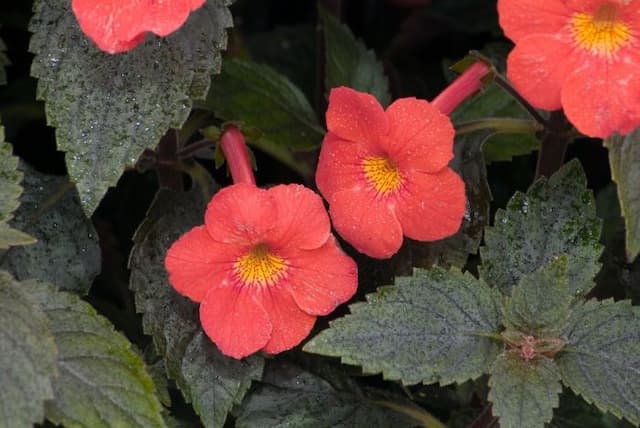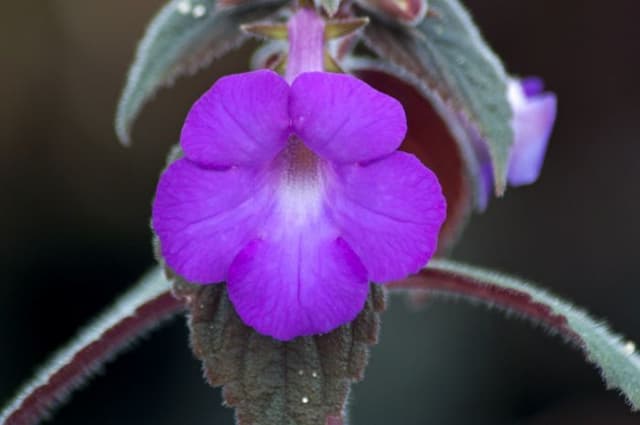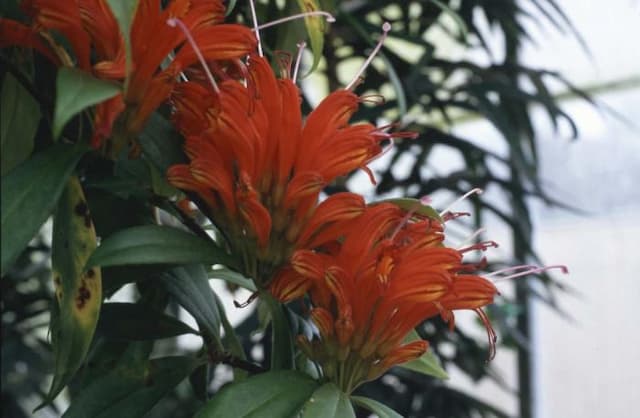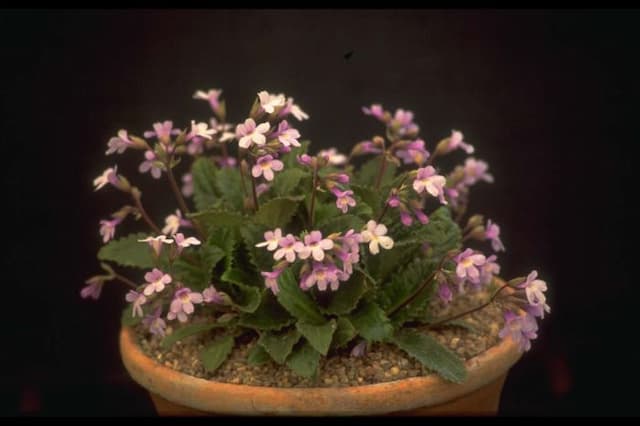Cape Primrose Streptocarpus 'Sweet Melys'

ABOUT
Streptocarpus 'Sweet Melys', commonly known as Cape Primrose, displays a lush rosette of soft, velvety leaves that spread outwards. The leaves are typically dark green, often with a slightly ruffled or wavy edge, creating a textured look that adds to the overall lushness of the plant. The true standout feature of the Cape Primrose is its flowers. They bloom in clusters on slender, upright stalks that rise elegantly above the foliage. The blossoms are trumpet-shaped with delicate, fluted edges, and come in a palette of colors, but 'Sweet Melys' is known for its particularly sweet, pastel shades that may have intricate patterns or markings. The flowers evoke a sense of gentle beauty that complements the softness of the foliage. This is a plant cherished for its ornamental flowers and attractive leafy base, often found brightening up indoor spaces.
About this plant
 Names
NamesFamily
Gesneriaceae.
Synonyms
Cape Primrose, African Violet Cousin, Nodding Violet.
Common names
Streptocarpus 'Sweet Melys'
 Toxicity
ToxicityTo humans
Cape Primrose (Streptocarpus 'Sweet Melys') is not considered toxic to humans. As with any non-edible plant, ingestion of considerable amounts can cause mild stomach upset, but it does not contain significant toxins that would lead to severe poisoning or life-threatening symptoms.
To pets
Cape Primrose (Streptocarpus 'Sweet Melys') is generally considered non-toxic to pets. Ingesting this plant should not result in serious illness for domestic animals, such as cats and dogs. However, as with any plant, consumption of large quantities may cause mild gastrointestinal upset, including symptoms such as vomiting or diarrhea.
 Characteristics
CharacteristicsLife cycle
Perennials
Foliage type
Evergreen
Color of leaves
Varies
Flower color
Mixed
Height
1 foot (30 cm)
Spread
1 foot (30 cm)
Plant type
Herb
Hardiness zones
10
Native area
Africa
Benefits
 General Benefits
General Benefits- Easy to care for: Streptocarpus 'Sweet Melys', also known as Cape Primrose, is low maintenance and suitable for indoor environments.
- Long blooming period: Cape Primrose often has a lengthy flowering duration, providing continuous beauty with its blooms.
- Attractive foliage: The plant has attractive, textured leaves that provide visual interest even when it's not in bloom.
- Compact size: It is well-suited for small spaces such as apartments or offices due to its compact growth habit.
- Can brighten up spaces: The vibrant flowers can add a splash of color and brighten up indoor spaces.
- Variety of colors: Comes in a range of colors, which allows for personalization of decor based on individual preferences.
- Promotes well-being: Enjoying the growth and blooming of plants like Cape Primrose can improve mental wellbeing by providing a sense of accomplishment and relaxation.
 Medical Properties
Medical PropertiesThis plant is not used for medical purposes.
 Air-purifying Qualities
Air-purifying QualitiesThis plant is not specifically known for air purifying qualities.
 Other Uses
Other Uses- Photography Prop: Streptocarpus can serve as an elegant and colorful subject for macro photography, allowing photographers to capture the fine details of its bloom.
- Teaching Tool: Biology teachers may use the Streptocarpus as an example to demonstrate flower parts, pollination, and plant care to students.
- Crafting Inspiration: Artists can draw inspiration from the vibrant colors and patterns of the Streptocarpus for various crafting projects, such as painting or textile design.
- Educational Displays: Botanical gardens might showcase Streptocarpus as part of educational displays informing visitors about different plant species and their habitats.
- Color Therapy: The plant's rich hues can be used in color therapy sessions to provide comfort and stimulate senses for emotional well-being.
- Personalized Gifts: Streptocarpus, with its long-lasting flowers and low maintenance, can be potted and given as personalized gifts for occasions like housewarmings or as part of gift baskets.
- Table Centerpieces: Due to their appealing foliage and bloom, they can be used as living table centerpieces during events or in home decor.
- Plant Swap Events: Streptocarpus can be propagated and shared at plant swap events, contributing to the diversity of plants within a community of enthusiasts.
- Art Subjects: They can be used by artists as subjects for botanical illustration, inspiring watercolor paintings or detailed drawings.
- Feng Shui: Some people use Streptocarpus in their home decor according to Feng Shui principles to attract positive energy.
Interesting Facts
 Feng Shui
Feng ShuiThe Cape Primrose is not used in Feng Shui practice.
 Zodiac Sign Compitability
Zodiac Sign CompitabilityThe Cape Primrose is not used in astrology practice.
 Plant Symbolism
Plant Symbolism- Resilience - Streptocarpus, commonly known as Cape Primrose, can flourish indoors with minimal attention, symbolizing an ability to thrive in challenging conditions.
- Enduring Love - With its long-lasting flowers, Cape Primrose is often associated with steadfast love and the endurance of affection through time.
- Optimism and Hope - The bright and cheerful blooms of the Cape Primrose bring a sense of optimism and are often used to convey hope in difficult situations.
 Water
WaterFor a Cape Primrose, like the 'Sweet Melys,' water regularly to maintain lightly moist soil without allowing it to become soggy. Typically, water once a week with room-temperature water, giving about 8 ounces per watering for a standard 6-inch pot. Reduce frequency during the cooler months when the plant's growth slows down. Bottom watering by placing the pot in a tray filled with water for about 30 minutes is effective at ensuring even moisture distribution. Allow excess water to drain away completely to avoid root rot.
 Light
LightCape Primroses, including 'Sweet Melys,' thrive in bright, indirect light. An east or north-facing window that provides a few hours of gentle morning sun or dappled light suits them best. Avoid placing them in direct, harsh sunlight, especially during the hot afternoon hours, as it can scorch their leaves.
 Temperature
TemperatureCape Primroses prefer temperatures between 60 and 75 degrees Fahrenheit. They can survive minimum temperatures of around 50 degrees Fahrenheit but should be protected from anything colder. Ensure stable temperatures without sudden drafts or fluctuations for optimal growth.
 Pruning
PruningPruning Cape Primroses, such as 'Sweet Melys,' encourages bushier growth and more blooms. Trim away any spent flowers and yellowing leaves to maintain the plant's appearance and health. The best time for pruning is immediately after a flowering cycle or in early spring before new growth begins.
 Cleaning
CleaningAs needed
 Soil
SoilThe best soil mix for Cape Primrose (Streptocarpus 'Sweet Melys') should be light and well-draining. A mix of peat moss, perlite, and vermiculite in equal parts works well. The soil pH should be slightly acidic to neutral, ideally between 5.8 and 6.5.
 Repotting
RepottingCape Primrose (Streptocarpus 'Sweet Melys') should be repotted once a year, preferably in spring, to refresh the soil and accommodate root growth. It's best to repot before the plant becomes root-bound.
 Humidity & Misting
Humidity & MistingCape Primrose (Streptocarpus 'Sweet Melys') thrives in moderate to high humidity levels, preferably between 50% and 70%, which helps promote healthy leaf and flower development.
 Suitable locations
Suitable locationsIndoor
Place in bright, indirect light away from drafts.
Outdoor
Protect from direct sun; place in partial shade.
Hardiness zone
10-11 USDA
 Life cycle
Life cycleThe life of Streptocarpus 'Sweet Melys', commonly known as Cape Primrose, begins with seed germination, where moisture and warmth encourage the tiny seeds to sprout and form a small rosette of leaves. The vegetative stage is characterized by the growth of lush, velvety foliage, with leaves potentially reaching several inches in length. This is followed by the flowering stage, during which the Cape Primrose produces tubular flowers with flared mouths, displaying a wide array of colors and patterns; the blooms often last for several weeks. After pollination, typically by insects, the flowers will produce seed capsules that, when mature, split open (dehisce) to release seeds for the next generation. If not allowed to go to seed, the plant can enter a vegetative rest period or continue to produce flowers in favorable conditions. Cape Primrose can also be propagated vegetatively via leaf cuttings, where a single leaf can produce multiple plantlets, bypassing the seeding stage and accelerating the life cycle.
 Propogation
PropogationPropogation time
Spring-Early Summer
Streptocarpus 'Sweet Melys', commonly known as Cape Primrose, can be propagated effectively through leaf cuttings, which is the most popular method. This technique involves taking a healthy, mature leaf and cutting it into horizontal strips that are about 2 to 3 inches (5 to 7.6 centimeters) in length. The lower end of the strips is then inserted into a moist, well-draining, soilless potting mix or a medium like vermiculite or perlite. The pot should be kept in a warm place with filtered light, as direct sunlight can be too harsh for the cutting. Enclosing the pot in a clear plastic bag can help maintain humidity, which is beneficial for root development. Rooting typically occurs within a few weeks, after which the new plants can be carefully transplanted into individual pots.









